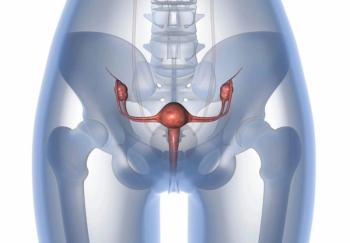
Oncology NEWS International
- Oncology NEWS International Vol 11 No 3
- Volume 11
- Issue 3
DX-8951f/Gemcitabine Safe, Active in Advanced Solid Tumors
NEW YORK-The combination of gemcitabine (Gemzar) and a potent, novel topoisomerase-1 inhibitor similar to irinotecan (Camptosar) is safe, has predictable toxicities, and has demonstrated significant antitumor activity in a variety of solid malignancies, according to results of a 70-patient phase I/pharmacokinetic study.
NEW YORKThe combination of gemcitabine (Gemzar) and a potent, novel topoisomerase-1 inhibitor similar to irinotecan (Camptosar) is safe, has predictable toxicities, and has demonstrated significant antitumor activity in a variety of solid malignancies, according to results of a 70-patient phase I/pharmacokinetic study.
The agent, known as DX-8951f, or exatecan mesylate (Daiichi Pharmaceutical Corp.), is structurally related to irinotecan and is approximately 3 to 10 times more potent than the active metabolite of irinotecan, SN-38, Eileen O’Reilly, MD, said at the Chemotherapy Foundation Symposium XIX. Dr. O’Reilly is assistant attending physician, GI Oncology Service, Memorial Sloan-Kettering Cancer Center.
Not a Prodrug
"Exatecan differs from irinotecan in that it is not a prodrug, so it doesn’t need to be metabolized for activation, and it has greater in vitro potency," she said.
The investigators chose to combine exatecan with gemcitabine because they both have a broad spectrum of activity, and their toxicity profiles are "relatively nonoverlapping," Dr. O’Reilly said. Also, in vitro studies suggest that the two have additive, if not synergistic, effects in pancreatic and other tumor cell lines.
As a single agent, exatecan has, in phase I studies, shown antitumor activity in small-cell lung cancer, sarcoma, bladder cancer, colon cancer, and other cancers. A 39-patient phase II trial presented at ASCO 2001 (San Francisco) showed that the agent was active in advanced pancreatic cancer, with a median survival of 10.8 months and 4.2 months, respectively, for untreated and pretreated patients.
70 Patients Enrolled
The current study enrolled 70 patient with advanced solid tumor malignancies, including 47 minimally pretreated patients (untreated or progressing after first-line treatment) and 23 heavily pretreated patients. More than half of the patients had pancreatic tumors.
Exatecan was given in a variety of doses (IV over 30 minutes) followed by gemcitabine (IV over 30 minutes) on days 1 and 8 of a 22-day cycle.
In minimally pretreated patients, dose-limiting toxicities were hematologic (neutropenia and neutropenic sepsis). Nonhematologic toxicities included grade 3 nausea and vomiting, along with grade 3 fatigue. The identified doses for subsequent phase II-III trials were exatecan, 2 mg/m² (conservative, since dose-limiting toxicity was achieved at 2.5 mg/m²), and gemcitabine, 1,000 mg/m².
In heavily pretreated patients, investigators identified a "stopping dose" of exatecan of 2.5 mg/m² and of gemcitabine of 750 mg/m², based on findings in the minimally pretreated cohort. As expected, these patients had greater hematologic toxicity (neutropenia and thrombocytopenia), compared with minimally pretreated patients at the same dose levels.
Pharmacokinetic analyses showed no significant interactions between the two drugs. Dr. O’Reilly said that the linearity of exatecan pharmacokinetics was maintained and remained dose-dependent despite coadministration with gemcitabine.
Antitumor activity included one complete response in a patient with pancreatic cancer, along with partial responses in patients with pancreatic and ovarian cancer. Prolonged, stable disease was seen in pancreatic cancer, hepatoma, and GE junction cancers. "There were suggestions of tangible antitumor response at all dose levels, including patients in the initial cohorts who continue on treatment, now approaching 18 months," she said.
A phase III trial of the combination vs gemcitabine alone is underway in untreated stage IV pancreatic cancer.
Articles in this issue
almost 24 years ago
Bush to Complete 5-Year Doubling of NIH Budgetalmost 24 years ago
CAD Accurate in Digital Imagesalmost 24 years ago
Campath-1H Safe and Effective in Refractory B-CLLalmost 24 years ago
Involved-Field RT Is Effective in Hodgkin’s Diseasealmost 24 years ago
FDA Approves Orfadin for Hereditary Tyrosinemia Type 1almost 24 years ago
Allovectin-7 Immunotherapy Active in Metastatic Melanomaalmost 24 years ago
HAART Ups Survival in Primary CNS Lymphoma Patientsalmost 24 years ago
Pseudomonas aeruginosa Infections After Transplant Rare But Deadlyalmost 24 years ago
ODAC Recommends That FDA Approve Zometa for Bone Metastasesalmost 24 years ago
CAD Equivalent to Double-Read Mammogram ScreeningNewsletter
Stay up to date on recent advances in the multidisciplinary approach to cancer.

















































































